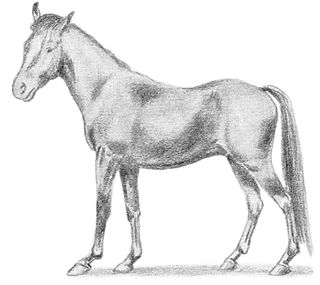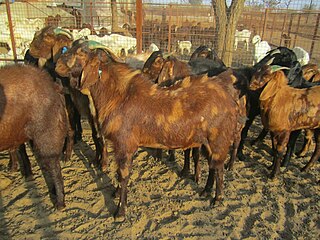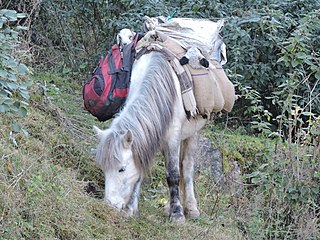
The American Belgian Draft is an American breed of heavy draft horse. It derives from the draft horses of Belgium but, as a result of isolation and different selective breeding, became genetically distinct from them in the early part of the twentieth century. It is generally taller and less heavily built, and has a very different distribution of coat colors.

The Boer or Boerbok is a South African breed of meat goat. It was selectively bred in the Eastern Cape from about 1920 for meat qualities and for the ability to survive by grazing on the thorn veldt of that region. It has been exported to many countries, and has been used to improve the meat qualities of other breeds.

The Marwari or Malani is a rare breed of horse from the Marwar region of Rajasthan, in north-west India. It is closely related to the Kathiawari breed of the Kathiawar peninsula of Gujarat, with which it shares an unusual inward-curving shape of the ears. It is found in all equine colours, including piebald and skewbald. It is a hardy riding horse; it may exhibit a natural ambling gait.

The Zaniskari or Zanskari is a breed of small mountain horse or pony from Ladakh, in northern India. It is named for the Zanskar valley or region in Kargil district. It is similar to the Spiti breed of Himachal Pradesh, but is better adapted to work at high altitude. Like the Spiti, it shows similarities to the Tibetan breeds living on the other side of the Himalayas in neighbouring Tibet. It is of medium size, and is often grey in colour. The breed is considered endangered, as there are only a few hundred alive today, and a conservation programme has been started at Padum, Zanskar, in the Kargil district of Ladakh.

The Knabstrupper or Knabstrup is a Danish breed of warmblood horse. It is principally a riding horse, but is also used as a harness horse and as a circus animal.

The Gir or Gyr is an Indian breed of zebuine cattle originating in the state of Gujarat. Other names include Bhodah, Desan, Gujarati, Kathiawari, Sorthi and Surti.

The Lundy Pony is a British breed of pony bred on Lundy Island in the twentieth century.

The Manipuri Pony is a traditional Indian breed of small horse or pony from Assam and Manipur in north-eastern India. It appears both in the history and the mythology of Manipur, and was used for warfare and polo. It is believed to have been the polo pony in use in Assam in the mid-nineteenth century when British tea planters first saw polo being played, and the height limits set for polo ponies were based on ponies of this breed. It was very numerous in the early twentieth century, but numbers have since fallen. A breed society was established in 1977, and a breed standard was drawn up by the Indigenous Horse Society of India in 2009.
The Indu-Brasil or Indo-Brazilian is a Brazilian breed of zebuine beef cattle. It was bred in the early twentieth century in the Triângulo Mineiro in the western part of Minas Gerais state, and particularly in the area surrounding Uberaba. It was originally known as the Induberaba. It derives from imported Indian zebuine cattle, principally Gir and Kankrej. It was formerly an important beef breed, but in the twenty-first century is an endangered breed. It is characterised by particularly large ears, perhaps the largest seen in any breed of cattle.

The Gelderlander is a Dutch breed of warmblood horse. It was bred in the province of Gelderland in the Netherlands as a carriage horse capable also of farm work. It declined in popularity in the mid-twentieth century. In 1965 it was one of the foundation breeds of the Dutch Warmblood or KWPN, the other being the heavier Groninger horse from the north. It is registered in a division of the Royal Dutch Warmblood Horse Studbook, which also has divisions for the Dutch Warmblood and for the Dutch Harness Horse.

The Sardinian Anglo-Arab or Anglo-Arabo Sardo is an Italian breed of riding horse from the Mediterranean island of Sardinia. It derives from cross-breeding of local mares with stallions of Arab, Anglo-Arab and Thoroughbred stock. Breeding began in 1874; the breed was officially recognised in 1967.

The National Research Centre on Equines (NRCE) was established during 7th five-year plan under the aegis of Indian Council of Agricultural Research for research on equine health and production considering the importance of equines in India.

The Boerperd is a modern breed of horse from South Africa. It is a re-creation of the traditional Cape Horse or old-type Boer Horse, which is now extinct.

The Sirohi is an Indian breed of domestic goat. It is named for its area of origin, the Sirohi District of Rajasthan, in north-western India. It may be described as a dual-purpose breed, reared for both meat and milk production, or as meat breed. It is well adapted to the dry tropical climate of Rajasthan.

The Marwari is an Indian breed of domestic sheep. It originates in, and is named for, the Marwar region of south-western Rajasthan, in the north-west of India. It is reared in the five principal districts of Marwar – Barmer, Jalore, Jodhpur, Nagaur and Pali – and also in some neighbouring districts of Rajasthan and Gujarat.

The Kiso or Kiso Horse is one of the eight indigenous horse breeds of Japan. It is the only native horse breed from Honshu, the principal island of Japan. Like most other Japanese native breeds, it is critically endangered.
The Bhutia Horse is a breed of small mountain horse from Sikkim and the district of Darjeeling in northern India. It has some similarity to Mongolian and Tibetan breeds. The usual coat colours are bay and grey.

The Spiti Horse is a breed of small mountain horse or pony from Himachal Pradesh in northern India. It takes its name from the Spiti River, and is found mainly in the Kullu, Lahaul and Spiti and Kinnaur districts of the state.

The Lac La Croix Indian Pony (LLCIP), also known as the Ojibwe pony is a semi-feral Canadian horse breed developed by the Ojibwe people. The population became critically low; and, by 1977, only four mares remained. To preserve the breed, these mares were crossed with Spanish Mustang stallions. The modern breed name derives from the Lac La Croix First Nation of Ontario, where the horses were last found in the wild. Historically, the breed was also found in Minnesota.



















